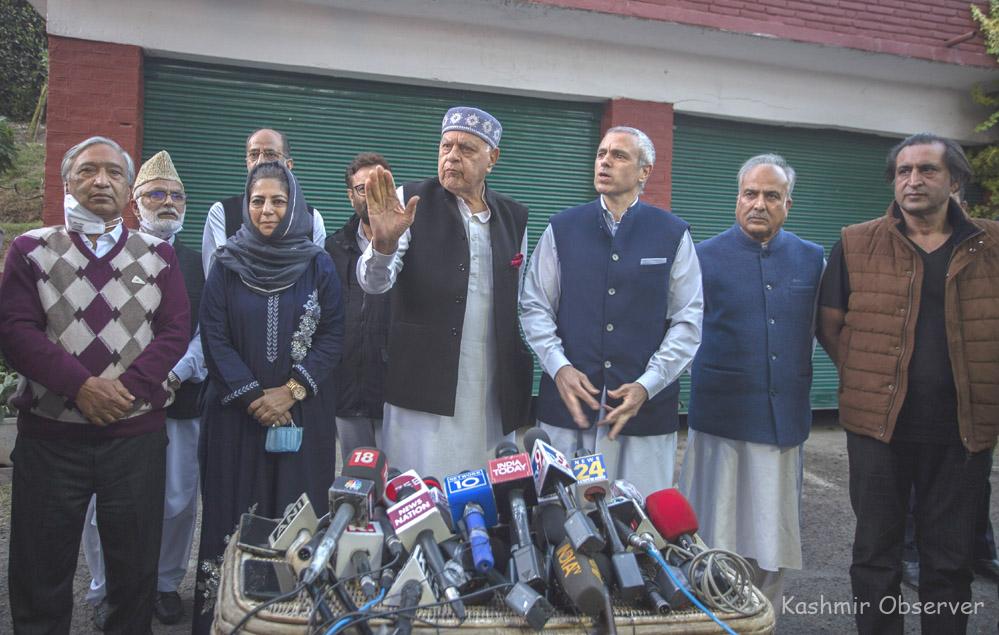
Less than six months since its formation, the PAGD seems about to come loose
WHEN the People’s Alliance for Gupkar Declaration was formed in April last year, few people in Kashmir expected it to last. But no one expected it to fall apart so soon. With the exit of the People’s Conference, the alliance has been left reeling and if nothing is done to give it a fresh sense of purpose, the remaining constituents may too go their separate ways.
The reason for the PC chief Sajad Gani Lone to leave the PAGD is the fielding of proxy candidates against one another by the constituent parties in the recent District Development Council polls. Lone has termed it “a breach of trust” and rightly so. After the PAGD nominated candidates to contest the DDC election, the constituent parties also fielded their own candidates. So, the PAGD candidates not only had to contend with the candidates from the BJP and the parties like Apni Party but also with the candidates from the PAGD constituents. This resulted in the defeat of many of them. The independent candidates, many of them from the PAGD constituents, ended up winning a whopping 49 seats. If there were no independents running on behalf of the PAGD parties, the grouping’s tally would be far higher than the 110 seats it garnered. And this, in turn, would have established more forcefully the demand for the restoration of J&K autonomy, the raison d’etre of the PAGD.
But why was this not done? The answer to this question is not far to seek. In the new grassroots governance scheme at the district level, a DDC chairperson or a DDC member will wield a huge political clout. They will be more or less exclusively charged with the development of the district. The DDCs have almost become mini-assemblies. As a result, a DDC chairperson and the members will be in a position to build a vaunted support base for their respective parties. This is where the conflict arises among the parties. More so, when the parties would not only want to preserve their traditional support base but also expand it. So, while politically, the parties may have a common cause and seek to fight an election jointly, the arrangement works against their respective electoral interests.The National Conference thus wouldn’t want to dilute its standing as the dominant political party, so wouldn’t the PDP, now the second major political outfit. And the People’s Conference, being still a marginal political player would want to outgrow its Kupwara confines which as a part of the PAGD it couldn’t hope to do.
Could the parties have resolved these contradictions in pursuit of their larger political cause? They certainly could have. India has had durable political groupings like the National Democratic Alliance and the United Progressive Alliance. There have been alliances in the states too. Mahagathbandan defeated the BJP in 2015 Bihar Assembly polls and came close to repeating the feat again in the last election, this time without the JDU of Nitish Kumar. This, despite the fact that these coalitions have been primarily about the pursuit of power. But when the PAGD was formed it had a larger cause, one that also had a moral resonance. And the alliance too had stressed this point saying there can be, “nothing about us, without us”.
“We want to assure the people that all our political activities will be subservient to the sacred goal of reverting to the status of J-K as it existed on 4th August 2019,” the Gupkar Declaration issued in August had stated adding that the constituents would be “bound, wholly, by the contents of the Gupkar Declaration and will unwaveringly adhere to it”.
But less than six months on, the PAGD seems about to come loose. It may still be a group of five parties, two of them the NC and the PDP, but the PC’s exit seems to have taken the sting out of the alliance. It suddenly appears vulnerable and shorn of its promise. And all this over an apparent conflict that could have easily been resolved had the leaders deemed it worth their while to sit together and talk. But this apparently was not done, nor sought by the parties. Why? There is no easy answer. It looks intriguing why exiting the alliance should have been the first option for the PC unless the party had been despaired of the redressal.
As for the future, it will be interesting to see how the remaining parties in the PAGD will conduct themselves. With the NC and the PDP still together, the alliance can be a force to reckon with and certain to be a major player in the government formation in future. As for pressing the demand for restoration of Article 370, all that the parties seem capable of doing as of now is to stick together. There has been no attempt to even symbolically register displeasure about what was done to J&K. And for obvious reasons. Centre has disproportionately raised costs for any show of even a symbolic defiance and this includes forming an alliance too. It remains to be seen how the remaining parties in the PAGD will respond to the costs of staying together.
The views expressed in this article are the author’s own and do not necessarily reflect the editorial stance of Kashmir Observer
Follow this link to join our WhatsApp group: Join Now
Be Part of Quality Journalism |
Quality journalism takes a lot of time, money and hard work to produce and despite all the hardships we still do it. Our reporters and editors are working overtime in Kashmir and beyond to cover what you care about, break big stories, and expose injustices that can change lives. Today more people are reading Kashmir Observer than ever, but only a handful are paying while advertising revenues are falling fast. |
| ACT NOW |
| MONTHLY | Rs 100 | |
| YEARLY | Rs 1000 | |
| LIFETIME | Rs 10000 | |













